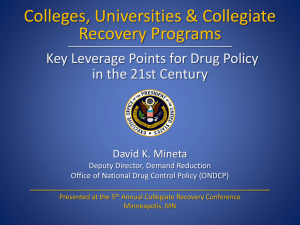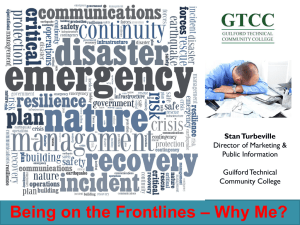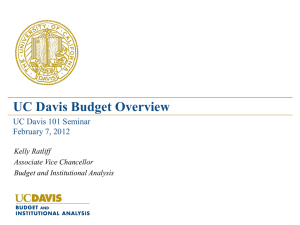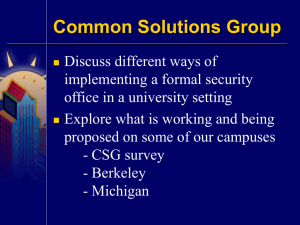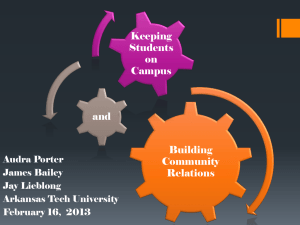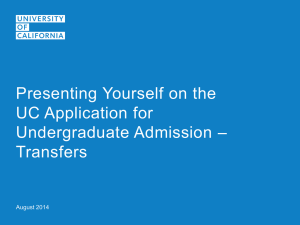Stewards of Place II Study: Preliminary Report
advertisement
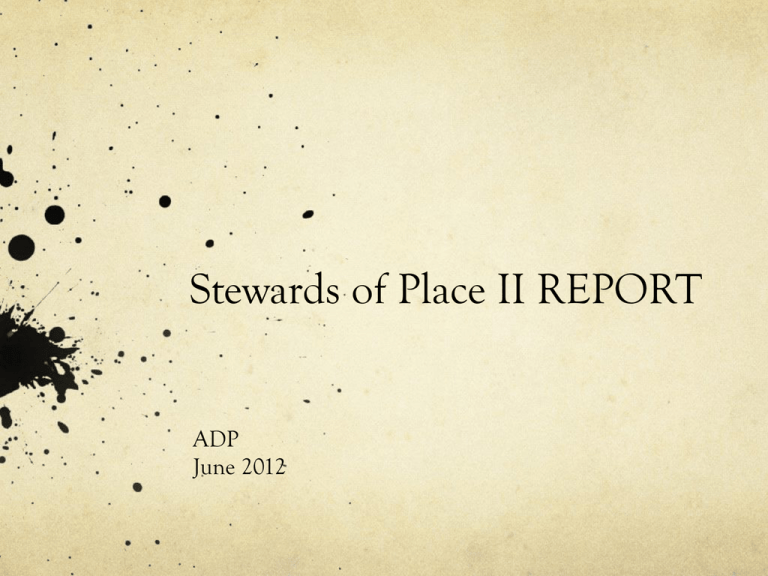
Stewards of Place II REPORT ADP June 2012 Institutional Stewards of Place “From their earliest days, state colleges and universities have diligently served in their role as stewards of place, answering the call to join with public and private partners in their communities and regions to take advantage of opportunities and confront challenges. On issues ranging from economic development to school reform to regional planning to environmental protection and more, public higher education institutions have teamed up with a wide range of local stakeholders to identify problems, explore potential solutions, and test those solutions in real life.” Being a Steward of Place What are some examples of how your campus enacts its core identity as an institutional steward of place? Research Team Dwight Giles, Jr.,University of Massachusetts, Boston KerryAnn O’Meara, University of Maryland, College Park Gene Rice, AACU John Saltmarsh, University of Massachusetts, Boston Lorilee Sandmann, University of Georgia Purpose Examine and analyze the 2008 and 2010 AASCU campus applications for the Carnegie Community Engagement Classification (71 campuses*) to gather evidence of what kinds of Stewards of Place institutional practices are occurring on AASCU campuses. The aim is to understand existing practices as a basis for formulating recommendations for campuses to enact practices that make them more effective stewards of place. *in 2010, of the 33 AASCU applications available for analysis, we had permission to only use 29. “If public engagement is to be such a significant part of the daily lives of colleges and universities, it is extremely important to be clear on just what that entails…[there is] the risk that the term can say everything and nothing at the same time. Additionally, the lack of a clear definition can leave some campuses and their leaders with the impression that they are “doing engagement,” when in fact they are not. (p.8)” Carnegie Foundation Community Engagement “Describes the collaboration between institutions of higher education and their larger communities (local, regional/state, national, global) for the mutually beneficial exchange of knowledge and resources in a context of partnership and reciprocity.” AASCU and the Carnegie Classification AASCU Classified Campuses as a percentage of all AASCU member campuses 2008…………8.7% 2010…………7.8% AASCU Classified Campuses as a percentage of all Classified Campuses 2006……….30.6% 2008……….34.2% 2010……….28.7% Total across all three classification cycles: 31.25% Size (FTE) <5000 = 7% 5000-10,000 = 30.9% 10,000-15,000 = 28.1% 15,000-20,000= 15.4% 20,000-30,000 = 11.2% 30,000-40,000 = 2.8% >40,000 = 4.2% Carnegie Basic Classification BA (all) – 10.1% MA (all) – 63.7% DRU – 10.1% RU-H – 13% RU-VH – 4.3% The Data from the Carnegie Community Engagement Classification Applications was analyzed within the context of the 2002 Stewards of Place Report. Analysis Areas of focus Mission Leadership Strategic planning Infrastructure Assessment measures Partnerships (patterns) Outreach (economic development) Emerging practices Faculty development Promotion and Tenure Prevalence guidelines Curricular structures Learning outcomes Examples Mission The Carnegie Foundation Community Engagement Documentation Framework begins with “Foundational Indicators” that address “Institutional Identity and Culture.” The first question of the framework has to do with the mission of the campus: Does the institution indicate that community engagement is a priority in its mission statement (or vision)? The 2002 Stepping Up as Stewards of Place report claimed that “the work of the engaged institution is to be responsive to public needs in ways that are appropriate to the institution’s mission and academic strengths. (p. 9)” It recommended that “engagement must become as deeply embedded in the institution as other mission dimensions (p.8)” and that “Institutional connections through partnerships are powerful vehicles to affirm institutional mission. (p. 11)” The report also found that a characteristic of a “fully engaged institution” is “Mission statements that identify the region to be served and highlight the importance of public engagement (p. 19)” and recommended that campuses “formally recognize responsibility to the community/region in the institution’s statement of mission and vision. (p. 33)” 68.5% of the AASCU campuses referenced their region in their mission statement. These were specific references to commitment to a geographical area smaller than a state (region, neighbors, area, urban, city) and often included the local and the global: “the university is committed to advancing the regional and global community through scholarly activities, research and public service;” “We envision engaged citizens of [X University] (students, faculty, and staff) who genuinely invest in their university community and their host communities (locally, regionally, nationally and globally).” The mission statements reveal some common characteristics related to community engagement including 1. Outcomes linking student learning to engagement in the community; 2. The integration of teaching, research, and service connected to engagement; and 3. Specific research connection to engagement. Outcomes linking student learning to engagement in the community: Just over 13% of the mission statement responses made a specific connection between student learning outcomes and engagement in the community. This number does not include 9% of the responses that include the term “service learning,” signifying communitybased academic courses. The integration of teaching, research, and service connected to engagement: Mission statement responses in 12% of the cases made specific reference to the relationship of the core faculty roles to community engagement. Specific research connection to engagement: In 12% if the responses, the mission statement specifically reference the connection between research and engagement. Strategic Planning Strategic Planning was addressed in the Carnegie Foundation Community Engagement Documentation Framework through the question: Is community engagement defined and planned for in the strategic plans of the institution? The 2002 Stepping Up as Stewards of Place report provided guidance for campus leaders who were “determined that public engagement is an important element of their overall institutional mission and who now must think and act strategically in order to get all elements of the campus aligned and working together in support of public engagement efforts. (p. 10)” Aligning as a Steward of Place There is evidence that being an institutional “steward of place” shapes the strategic priorities of the AASCU campuses. For example, one campus responded that their “Strategic Plan…makes very explicit the importance of community engagement and stewardship of place…"Enhance [the campus’s] sense of stewardship of place by increasing its commitment to [the region]." Reciprocity and Collaboration There was also evidence of a framing of engagement with community that was reciprocal and mutually beneficial, valuing the assets that the community brought to the partnerships: “Provide opportunities to learn from external communities through internships, cooperative education, and other field activities… Promote collaborative and innovative exchanges…to…enhance opportunities for all learners…Develop mutually beneficial working partnerships with public and private sectors;…Develop community-centered programs…” Economic Development: 35.8% of the responses identified economic development as a priority of community engagement. Commitment to K-12 schools: 15% of the responses specifically identified a strategic commitment to the local K-12 schools as a strategic priority. Connecting community engagement to student retention and success: 12% of the responses specifically identified the retention and success of undergraduates as a dimension of their community engagement strategy. Commitment to Region The 2002 report Stepping Up as Stewards of Place found that “Regional service is far down (or missing from) most institutions’ lists of strategic priorities. They are much more interested in growth, improvements in teaching and learning, creating or improving institutional capacity (acquiring new academic programs, technology, buildings and faculty and improving faculty salaries). (14)” Based on the data from our study, 64% of the Strategic Planning responses in the Carnegie framework addressed regional priorities. Curriculum “Curricular Engagement describes the teaching, learning and scholarship that engages faculty, students, and community in mutually beneficial and respectful collaboration. Their interactions address community identified needs, deepen students’ civic and academic learning, enhance community well-being, and enrich the scholarship of the institution.” Curricular Engagement was addressed in the Carnegie Foundation Community Engagement Documentation Framework in part through the question: Is community engagement integrated into the following curricular activities? Student Research Student Leadership Internships/Co-ops Study Abroad The 2002 Stepping Up as Stewards of Place report claimed that “Public engagement is not an integral part of the curriculum for a majority of the AASCU institutions that responded to the survey—fewer than onequarter require students to complete an internship, cooperative experience, community service, or service learning activity as part of their academic program” (p. 14). Of the AASCU campuses that received the classification, 95% reported that community engagement is integrated into student research; 95.8% reported that it is included in a student leadership curriculum; 98.6% claimed that it was integrated into internships and/or co-op experiences; and 88.5% reported that it is part of study abroad experiences. Some examples of community engagement curriculum adoptions were in the following area: • The integration of CE as a requirement for graduation • The integration of CE as part of First Year Experiences • The adoption of CE in General Education goals, outcomes • Plans for Service-learning course designation, a CE minor and certificate program, a minor in Leadership Faculty Roles and Rewards The documentation framework asks the following questions related to faculty reward systems: Do the institutional policies for promotion and tenure reward the scholarship of community engagement? If yes, how does the institution classify community-engaged scholarship? (Service, Scholarship of Application, other) If no, is there work in progress to revise promotion and tenure guidelines to reward the scholarship of community engagement? The 2002 Stepping Up as Stewards of Place report found that “If engagement is ever to become a meaningful component of institutional mission, it must be reflected in the promotion and tenure policies, but done in an academically rigorous way” (p. 25). One of the recommended “Protocols for Engagement” was to “Align promotion and tenure criteria with the engagement agenda” (p.34). Our analysis has found that 23.8% of the classified AASCU campuses had claimed to have reformed P&T policies to redefine community engagement as scholarly activity. 22.3% had reformed P&T guidelines to note the importance of community engagement in faculty roles overall – in teaching, research, and service. 48% noted individual department recognition of community engagement in P&T policies. Infrastructure Does the institution have a campus-wide coordinating infrastructure(center, office, etc.) to support and advance community engagement? The 2002 Stepping Up as Stewards of Place study reported that “all of the site visit institutions have some type of center or institute dedicated to public engagement; most of these serve as a front door to the institution where community problems get matched with faculty research expertise. These CEO’s and their senior staff were almost unanimous in describing how they see the institution’s role not as “solving” the community’s problem, but rather providing the resources necessary to best understand it.” Responses from the applications indicate all of the campuses have some kind of coordinating infrastructure for community engagement and that 71.6% of the campuses have a center that functions as a centralized structure. Outreach and Partnerships According to the documentation framework, “Outreach and Partnerships describe two different but related approaches to community engagement. The first focuses on the application and provision of institutional resources for community use with benefits to both campus and community. The latter focuses on collaborative interactions with community and related scholarship for the mutually beneficial exchange, exploration, and application of knowledge, information, and resources (research, capacity building, economic development, etc.” Campuses we asked to use an excel document to enter information “to describe representative partnerships (both institutional and departmental) that were in place during the most recent academic year (maximum 15 partnerships).” The 2002 Stepping Up as Stewards of Place report identified a range of issues around which campus and community would form partnerships: “On issues ranging from economic development to school reform to regional planning to environmental protection and more, public higher education institutions have teamed up with a wide range of local stakeholders to identify problems, explore potential solutions” (p.7). 98.5% of the classified campuses identified Education and K-12 partnerships. 71.6% of the AASCU campuses were focused on community and economic development (local hiring and procurement, workforce development and training including leadership development, capital investment, etc.) 65.7% of the campuses identified partnerships formed out of a commitment to the underserved (specific focus on access and creating opportunities for first generation students and minority groups in local region). Leadership Does the executive leadership of the institution (President, Provost, Chancellor, Trustees, etc.) explicitly promote community engagement as a priority? “If a fully engaged institution is to be created, it will occur only with the active and visible leadership of the president or chancellor. While leadership from the top is necessary, it is by no means sufficient. Fully engaged institutions have a leadership network at all levels, comprised of persons who are both capable and willing to lead on behalf of the public engagement mission” (p. 18). “A recurring theme throughout this report is that leadership matters and leadership from the campus CEO matters most. They must not only talk the talk, but walk the walk” (37). 74.6% indicate that the President/Chancellor of the campus is explicitly promoting community engagement on campus. 55% of the applications identified the Provost/Chief academic Officer as promoting community engagement. Only 8 % of the campuses identified the Vice President/Chancellor for Student Affairs, and 4% identified positions such as Vice President for Economic Development, Public Relations, or Community Affairs. Six Key Recommendations 1. Partnerships enacted for mutual benefit, and that honor reciprocity, are a key strategy to achieve institutional excellence and leading-edge teaching, research, and professional service at AASCU institutions. 2. While AASCU institutions have taken steps to align faculty reward systems with their commitment to community engagement, there is still significant work to do in faculty recruitment, department cultures, the criteria used to assess scholarship, and the promotion and tenure review process. 3. Given the historical and significant commitment made by AASCU institutions to access for regional students and to improvement of local K12 school systems, AASCU institutions should now move to develop 5 and 10year benchmarks for improvement in these areas. 4. Campus commitments to regional economic development and resources expended to support local infrastructure and joint initiatives need to be made transparent and widely known on and off-campus. 5. Universities are increasingly the place where the knowledge, skills, and values of global citizenship are fostered. Also, increasingly, the communities of which AASCU campuses are a part are made up of individuals from across the globe. AASCU campuses should take the lead in developing all public engagement as global public engagement that includes intercultural learning outcomes regardless of where the engagement takes place. Being a Steward of Place recognizes that the local is global and the global is local. Global engagement takes place in the neighborhoods surrounding the campus. 6. A campus committed to public engagement defined by deeply collaborative and reciprocal partnerships with community-based organizations and individuals is also committed to organizational change affecting practices, structures, and policies. Steward of Place campuses, because of their local commitments and responsibilities have prioritized issues of diversity and inclusion, student success, and public engagement. Steward of Place campuses have the opportunity to develop practices, structures, and policies that facilitate the connections between these priorities. A “third way” for American higher education – a different model of academic excellence in an institutional Steward of Place Integration/Beyond Differentiation Collaboration/Beyond Hierarchy Inclusive/Beyond Diversity Engagement/Beyond Walls and Silos Networked/Beyond the Split Between Content and Process and Content and Context Contact: R. Eugene Rice: rice@AACU.org John Saltmarsh: john.saltmarsh@umb.edu
